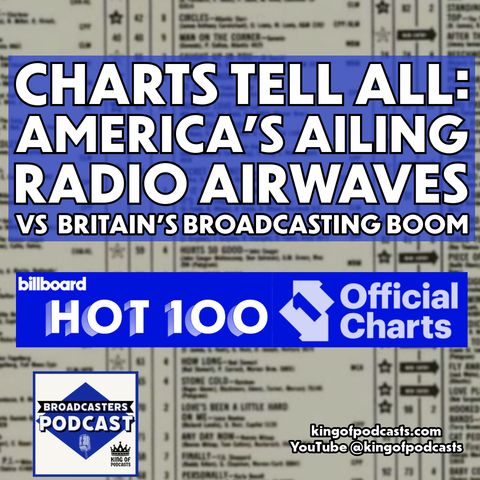Charts Tell All: America's Ailing Radio Airwaves vs Britain's Broadcasting Boom (ep.347)

Download and listen anywhere
Download your favorite episodes and enjoy them, wherever you are! Sign up or log in now to access offline listening.
Charts Tell All: America's Ailing Radio Airwaves vs Britain's Broadcasting Boom (ep.347)
This is an automatically generated transcript. Please note that complete accuracy is not guaranteed.
Description
The US radio broadcasting industry is experiencing a profound period of transformation. The signs of change are everywhere, from the swift rise and fall of hit songs to the radical...
show moreThe industry's long-held traditions are being dismantled. "This is how we've always done it" is no longer a valid excuse. Financial constraints and technological advancements are forcing radio groups to reinvent their operations from the top down. These changes are more significant than anything seen since the consolidation wave of the mid-1990s.
Meanwhile, a stark contrast exists across the pond. The UK radio scene is thriving, with stations like Capital and BBC Radio 1 posting their best audience shares in years. The energy and innovation in British CHR, fueled by a strong dance music component, is particularly striking.
This vibrancy underlines the challenges faced by US radio, where even the resurgence of CHR stations in London is a reminder of a fragmented market. The question remains: is radio in the US facing a mere evolution or an existential threat?
While the industry's struggles are evident, it's too early to write its obituary. The 80% of adults who still tune in weekly represent a vast and loyal audience. However, radio cannot rely solely on its past successes or its current reach.
To survive and thrive in the 21st century, radio must embrace change and innovation. It must adapt to new technologies, evolving listener habits, and the shifting media landscape. It must find ways to deliver compelling, relevant content that connects with audiences in a meaningful way. If it fails to do so, the future of radio may indeed be in jeopardy. The outcome is not a foregone conclusion, but the stakes have never been higher.
Billboard Charts (US) vs. Official Charts (UK): Contrasting Approaches to Radio Airplay
Billboard Charts:
* Heavy Emphasis on Airplay: Radio airplay holds significant weight in determining a song's position on the Billboard Hot 100. It's one of the three core metrics (alongside sales and streaming) used in the chart's calculation.
* Audience Impressions: The Billboard Radio Songs chart specifically tracks the estimated number of times a song is heard by listeners across various radio formats. This implies a focus on the reach and potential impact of a song on the radio.
Official Charts (UK):
* Reduced Emphasis on Airplay: While radio airplay is still a factor in the UK's Official Singles Chart, its influence has diminished in recent years. The chart now places greater importance on streaming and digital downloads.
* Playlists and Streaming: The Official Charts Company has adapted its methodology to better reflect the changing music consumption habits of UK listeners. This includes incorporating data from streaming platforms and playlist plays, acknowledging the growing influence of these platforms on music discovery.
Implications:
* US Radio's Lingering Influence: The continued importance of radio airplay on the Billboard charts suggests that traditional radio still holds considerable sway in the US music industry. However, the rapid turnover of chart-topping hits may signal a disconnect between radio programming and evolving listener preferences.
* UK's Digital-First Approach: The reduced reliance on radio airplay in the Official Charts reflects the UK's embrace of digital music consumption. This approach may enable the charts to better capture the true popularity of songs and artists, especially among younger demographics.
Conclusion:
The contrasting use of radio airplay in the Billboard and Official Charts highlights the differing landscapes of the US and UK music industries. While radio remains a key player in the US, the UK charts have adapted to the digital age, potentially reflecting a more dynamic and forward-thinking approach to measuring music popularity. These differences could contribute to the perceived struggles of US radio compared to the relative success of its UK counterpart.
Contact KOP for professional podcast production, imaging, and web design services at http://www.kingofpodcasts.com
Support KOP by subscribing to his YouTube channel and search for King Of Podcasts
Follow KOP on Twitter or Facebook @kingofpodcasts
Listen to KOP’s other programs, Depraved and Debaucherous… and the Wrestling is Real Wrestling Podcast and join my Supporters Club for any of these podcasts from the website.
Information
| Author | King of Podcasts |
| Organization | King of Podcasts |
| Website | - |
| Tags |
Copyright 2024 - Spreaker Inc. an iHeartMedia Company
